5 Essential Storyboarding Tips for Stop Motion Animation
To create a compelling stop motion animation, you'll want to start with a solid plan. Begin by identifying key story beats and plot points to guide your narrative structure. Consider the emotional arc of the story and experiment with different shot compositions, framing, and angles to evoke emotions through visual elements. Keep your frames simple, focusing on essential elements, and ensure character designs are consistent. As you refine your storyboard, experiment with revisions, and refine your pacing and timing. By mastering these essentials, you'll be well on your way to crafting a captivating visual narrative that will draw your audience in.
Key Takeaways
- Plan your visual narrative, identifying key story beats and plot points to guide the narrative structure of your stop motion animation.
- Keep frames simple and detailed, focusing on essential elements and using clean lines, basic shapes, and minimal textures.
- Use the rule of thirds, framing, and negative space to create visually appealing shots that draw the viewer's eye to the subject.
- Experiment with storyboard revisions, trying alternate scene orders, camera angles, and endings to find the most impactful narrative.
- Refine pacing and timing, adjusting scene length and key event timing to create an engaging and immersive experience for the viewer.
Plan Your Visual Narrative
When planning your visual narrative, you're essentially creating the blueprint for your entire story.
This involves breaking down your script into individual shots and scenes, allowing you to visualize the pacing, tone, and overall flow of your animation.
Start by identifying key story beats and plot points, as these will help guide your narrative structure.
As you plan your visual narrative, consider the emotional arc of your story.
Think about how you want your audience to feel at different points, and how you can use visual elements to evoke those emotions.
You should also consider the logistics of your animation, including character placement, camera angles, and movement.
Keep your visual narrative flexible, as it will likely evolve during the storyboarding process.
Don't be afraid to make changes and try out new ideas.
Your goal is to create a clear and engaging narrative that draws your audience in and keeps them invested in your story.
Understand Shot Composition Basics
Breaking down your visual narrative into individual shots is one thing, but making those shots visually appealing is another.
When it comes to shot composition, you'll want to consider the placement of your characters and objects within the frame. Think about the rule of thirds, where you divide your frame into thirds both horizontally and vertically.
Place important elements along these lines or at their intersections to create balance and visual interest.
Pay attention to framing, using elements within the scene to create a frame within a frame. This can help draw the viewer's eye to your subject.
Consider the negative space around your characters and objects, using it to create a sense of depth and atmosphere.
Don't be afraid to experiment with different angles and perspectives. A well-composed shot can elevate your entire scene and engage your audience.
By applying these shot composition basics, you'll be able to create visually appealing shots that bring your stop motion animation to life.
Keeping your shots simple and well-composed will also make the animation process easier to manage.
Create Simple Yet Detailed Frames
With your shot composition basics in place, it's time to create frames that not only capture your audience's attention but also transport them into your stop motion world.
When creating frames, keep in mind that simplicity is key. Avoid cluttering your scenes with too many details, as this can make your animation look busy and confusing.
Instead, focus on the essential elements that will drive the story forward. To achieve a balance between simplicity and detail, identify the main action or focal point in each frame and emphasize that. Use clean lines, basic shapes, and minimal textures to convey the necessary information.
Keep your character designs consistent and easy to read, making sure they're recognizable from various angles. Consider the lighting and atmosphere of each scene, as these elements can greatly impact the mood and tone of your animation.
Experiment With Storyboard Revisions
| Revision Strategies | Benefits |
|---|---|
| Swap scene order | Create suspense or surprise by rearranging the sequence of events |
| Add or remove characters | Simplify or complicate your narrative with character adjustments |
| Change camera angles | Experiment with different perspectives to add visual interest |
| Try alternate endings | Experiment with different conclusions to find the most impactful one |
Through revision, you can distill your story to its most essential elements and create a stronger narrative. Don't be afraid to try out new ideas or take risks – it's all part of the revision process. By experimenting with different approaches, you'll ultimately create a more polished and effective storyboard for your stop motion animation.
Refine Your Pacing and Timing
When refining your pacing and timing, you're essentially fine-tuning the heartbeat of your stop motion animation.
This is where you ensure that each scene flows smoothly into the next, creating a cohesive and engaging narrative. Start by reviewing your storyboard, paying close attention to the length of each scene and how it contributes to the overall pacing of your animation.
You'll want to consider the emotional impact of each scene and how it affects the viewer.
Ask yourself if the pacing feels natural or if it's dragging on. Make adjustments as needed, cutting or extending scenes to achieve the desired emotional response.
It's also essential to consider the timing of your animation's key events, such as dramatic reveals or comedic beats.
Ensure that these moments are expertly timed to maximize their impact. By refining your pacing and timing, you'll create a more engaging and immersive experience for your audience.
Frequently Asked Questions
Can I Use Digital Tools for Stop Motion Storyboarding?
You can use digital tools for storyboarding, which can be more efficient and easier to edit. Many apps offer similar functionality to traditional paper-based methods, and you can easily share your boards with team members digitally.
How Do I Storyboard for Non-Linear Narratives?
When storyboarding non-linear narratives, you're breaking from chronological order. You'll need to fragment your scenes and reassemble them to convey your character's disjointed experience, using visual cues to guide the viewer through time jumps.
What Software Is Best for Stop Motion Storyboarding?
You're looking for the best software for stop motion storyboarding. You'll find options like TVPaint Animation, OpenToonz, or Adobe Animate suitable for creating boards. These programs offer flexibility, collaboration tools, and intuitive interfaces you can master quickly.
Should I Include Sound Effects in My Storyboard?
You're deciding whether to include sound effects in your storyboard. In general, it's not necessary, as storyboards mainly focus on visuals. However, if sound effects are crucial to your narrative, you can include them as notes.
Can I Reuse Storyboards for Different Animation Projects?
You can reuse storyboards for different projects, but you'll likely need to adapt them to fit each new idea. You're essentially reworking the foundation, so expect to make significant changes to make it fit.
Conclusion
You've got your storyboarding tips in hand, and it's time to bring your stop motion animation to life. By planning your visual narrative, mastering shot composition, creating detailed frames, experimenting with revisions, and refining pacing and timing, you'll be well on your way to crafting a compelling and engaging film. Remember, a solid storyboard is key to a successful animation – so don't be afraid to keep refining until you get it just right.






